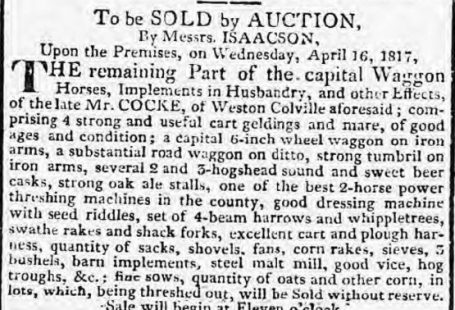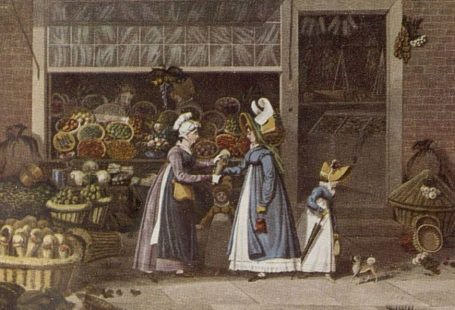This week at The Archive is a very special one, as today on the 29 November 2021 we celebrate our tenth birthday! It is ten years since we launched the British Newspaper Archive, and to celebrate this decade of digitising newspapers, we have added ten brand new titles to our collection, as well as updating ten of our existing titles, numbering 114,064 brand new pages in all.
So read on to find out more about all of our new ten titles, which hail from across England’s north and south, without neglecting the Midlands and also the country’s west! You can also discover which of our existing titles we have added to this week, as well as finding out more about West Ham United’s early history.
Register now and explore the Archive
And so we begin our look at our ten new titles of the week by starting in the north of England, with the Tees-side Weekly Herald. First published in Middlesbrough on 4 October 1902, this newspaper described itself as being ‘for Middlesbrough, Cleveland, Stockton, Thornaby, Darlington, the Hartlepools, and District.’ Costing just one penny, the eight page publication appeared every Saturday and generally featured a cartoon on its first page.

With a focus on local news, the Tees-side Weekly Herald contained such features as ‘Tees-side Topics,’ ‘News from the Pools,’ and ‘Darlington Notes,’ taking a look at ‘local controversies,’ the latest from Hartlepool Town Council and from the local police courts. But the lively newspaper, which was composed mainly of short paragraphs of news, also featured some special interest columns as ‘Nature Notes,’ ‘Musical Notes,’ and ‘Sports of the People,’ which reported on the ‘Tees-side Football Clubs’ Doings.’
Our next new title of the week hails from Staffordshire, and is the Leek Times. Describing itself as the ‘only local newspaper,’ having no ‘opposition within Ten Miles,’ the Leek Times was established in 1870 and cost one penny. Appearing every Saturday, the newspaper was neutral in its politics, representing ‘an extensive Agricultural and Manufacturing District.’

Published in the market town of Leek, and appearing on one of the town’s two market days, the Leek Times also circulated in ‘Cheddleton, Cheadle, Endon, Grindon, Butterton, Longnor and the whole of the Moorland district,’ whilst finding ‘its way in considerable numbers into the adjoining towns of Cheshire and Derbyshire.’ The four pages of this newspaper featured a general summary of news, covering both national and international news, as well as incorporating ‘Local and District Intelligence,’ for example reporting on the Staffordshire Sessions, local police news and the latest from the Board of Guardians.
To Nottinghamshire now for our third new title this week, and we are delighted to the welcome the Hucknall Morning Star and Advertiser to our collection. Established in the market town of Hucknall, famed for being near the residence of poet Lord Byron and the birthplace of author D.H. Lawrence, in 1885, in 1889 the newspaper incorporated rival radical title the Hucknall Advertiser. Costing one penny, and appearing every Friday, the Hucknall Morning Star was Liberal in its political affiliation, and was published from the High Street, Hucknall.

Covering eight pages, the Hucknall Morning Star focused on local news, which was ‘alphabetically arranged,’ reporting on the latest from Beauvale, Kirkby, Mansfield, Pinxton, and other nearby towns and villages. It also featured serialized fiction, for example a story entitled ‘Secret Chains,’ a look at gardening, and the work that was needing to be done for the week, reports on local cricket fixtures, as well as correspondence from readers. The Hucknall Morning Star also shone a light on local industry, with reports on miners’ conferences, as well as on local politics, reporting on ‘Mid-Derbyshire Radicalism.’ In 1909, the newspaper became the Hucknall Star and Rushcliffe Advertiser.
We stay in the Midlands now for our next new title, which is the Hinckley News. Published in the Leicestershire market town of Hinckley, this newspaper was first published on 5 October 1861 and circulated in ‘Hinckley, South Leicestershire, and North Warwickshire.’ A localised version of the Leicester Advertiser, the Hinckley News cost one penny and appeared every Saturday, the town’s market day.

In its inaugural edition the Hinckley News expressed its intention to ally itself with the workers of the area, the paper observing how:
We have long been of the opinion that a large mass of the deserving working classes have been almost ignored, and virtually unrepresented in the press.
To this end, it invited ‘correspondence from working men on all suitable subjects,’ although the newspaper reiterated its determination ‘not to ally ourselves with any political party.’ Meanwhile, the Hinckley News would ‘devote a certain space weekly to literary matters,’ as well as shining a light on ‘trade and other news of the district,’ and containing weekly summaries of news.
And our final new Midlands title of the week has the honour of being the Sutton Coldfield and Erdington Mercury, which was first published on 12 November 1887. Appearing every Saturday, and published in the Birmingham town of Sutton Coldfield, this newspaper spanned eight pages and contained ‘District Intelligence,’ with news, for example, from the Lichfield City Police, Lichfield adjoining the town, and the Staffordshire Agricultural Society. The Sutton Coldfield and Erdington Mercury also featured poetry, serialized fiction, football results and a ‘Lady’s Letter on Current Topics.’

Also joining The Archive this week are a trio of titles from London, and we kick off with the West Ham and South Essex Mail. Going through many name changes throughout its lifetime, the newspaper was originally known as the East & West Ham Gazette when it was first published on 7 April 1888. It then became the South Essex Gazette, then the West Ham and South Essex Gazette, being known as the West Ham and South Essex Mail between 1912 and 1928, before finally becoming the East Ham Echo and Barking Chronicle in 1928.

Appearing every Saturday, the West Ham and South Essex Mail hoped to be a ‘readable and widely circulated newspaper.’ Taking ‘no particular side in Politics,’ it hoped to ‘receive news from all sides of Political Opinions, as well as of Athletic and other Clubs.’ The newspaper reported on local news, such as the results of the East Ham Local Board Election, as well as news from further afield, both national and international. It also featured serialized fiction, with one featured story titled ‘My Wife or His,’ a look at ‘American Humour,’ and a ‘London Letter.’
We move south of the Thames now for our next new title of the week, which is the South London Journal. Established in 1834 and initially appearing every Tuesday from 15 Duke Street, London Bridge, the newspaper eventually switched to a Saturday publication day. With its full title of the South London Journal, North Surrey Herald and West Kent Guardian, this publication featured news from the nearby boroughs of Southwark and Lambeth, as well as from across Surrey. A particularly interesting feature of the South London Journal are the detailed advertisements for services across South London, headed under the district they were located in.

Our final new London title of the week is the Sydenham Times. First published on 28 January 1862, the Sydenham Times appeared every Tuesday and cost one penny. Spanning eight pages, the newspaper also covered news from the nearby localities of Norwood, Forest Hill, Streatham, Brixton, Dulwich, Lewisham, Penge, Anerley, Beckenham and Croydon, but the boom area of Sydenham was at its heart. Sydenham, in London’s south east, had become incredibly fashionable after the Crystal Palace was rebuilt on Sydenham Hill, with many fashionable residences being built in the area.
And the new newspaper declared that a ‘demand…has sprung up in this neighbourhood for a weekly paper that will circulate at a cheap price,’ due to an increase in literacy rates, which the Sydenham Times referred to as ‘these days of universal reading and writing.’ So the Sydenham Times rushed to fill this gap, nobly proclaiming, in its first edition, how:
It will ever be our earnest desire to wield our pen in the defence of truth, justice, and right; to plead the cause of the week, the friendless and the traduced; to expose cruelty; to fight against tyranny…

But what did the Sydenham Times contain? Well, it featured a look at ‘Topics of the Day,’ the ‘Latest from America,’ ‘Town Talk,’ and the ‘Latest Telegrams.’ A rich digest of national and international news, the publication also took in the latest from its local area, featuring reports from Norwood, Anerley, the Crystal Palace, and Croydon.
We depart London now for Bristol, for our penultimate new title, which is the South Gloucestershire Gazette, or to give it its full name, the South Gloucestershire Gazette, Shirehampton Times, Bristol and Avonmouth Weekly News. This title was first published in Bristol on 21 March 1913 at the cost of just one half penny, and it appeared with the intent to ‘present the latest news in a clean, attractive and intelligent manner.’

Indeed, the newspaper was intended for ‘the use of one and all,’ whilst its eight pages looked at general news from across the country, featuring ‘Observations upon Current Events,’ as well as items from closer to home, including a look at the city’s docks. The South Gloucestershire Gazette also featured a range of special interest items, such as an illustrated dressmaking column, as well as details on the ‘Week’s Gardening.’
Our final new title of the week is the Folkestone Chronicle, which when it was first published on 21 July 1855 at the cost of two pence, was known as the Folkestone Chronicle, and Visitor’s Guide to Folkestone, Sandgate and Their Neighbourhoods. Published in the Kent port town and resort of Folkestone, the newspaper was intended to give Victorian tourists all the information they needed about the town, such as its amenities, attractions and accommodation.
Circulating in ‘Folkestone, Sandgate, Shorncliffe Camp, Hythe and the neighbourhood,’ the Folkestone Chronicle aimed to ‘amuse…and in some cases…to instruct’ its readers, providing ‘correct information on all current events, including those of a local nature.’ It hoped to report ‘faithfully on all public business conducted within the Town and neighbourhood, whether magisterial or otherwise,’ whilst steering clear of ‘religious controversy, and party feeling.’

Containing, therefore, the ‘general news of the week…and a correct list of visitors,’ the Folkestone Chronicle also looked at political news, the latest ‘home news,’ and news from abroad, such as the ongoing Crimean War. The newspaper also contained announcements of births, marriages and deaths.
Well, that’s all from our ten new newspapers for ten years of The Archive! And we’ve also updated ten of our existing titles this week. Highlights from these updates include the over 16,000 pages we have added to the Newark Advertiser, and the over 5,000 pages that have joined the Birmingham Mail.
West Ham United – The Early Days
Premiership football club West Ham United can trace its origins back to the Thames Ironworks Football Club, which was founded in 1895 and is generally accepted to be the earliest incarnation of the famous London team.
Thames Ironworks FC was the works team of the Thames Ironworks and Shipbuilding Company, the last shipbuilding company on the Thames, and won the West Ham Charity Cup in 1895. Seeing increasing success in the following years, the amateur team won the London League in 1897, before turning professional in 1898. And in 1900, despite the team’s success, Thames Ironworks FC was disbanded over arguments about how they were to be financed. However, the team was quickly relaunched, and this time it was to be known as West Ham United.

And with the addition of the West Ham and South Essex Mail to The Archive, we wondered if we could find any early mentions of Thames Ironworks FC, the team that preceded West Ham United.
We did. On 21 December 1895, the year that Thames Ironworks FC was founded, we discovered a short report on the South Essex Matches that had taken place recently, listing all the teams that had played and the results. It is a short entry, but notable because of its importance in the history of football:
Thames Ironworks (A) 5, St. Luke’s Reserves 1.

We can already see that the club is on a successful trajectory, a path that would lead to a switch to professionalism, and eventual victories in the F.A. Cup in the 1960s and 1970s.
And we found another mention of the Thames Ironworks team in the West Ham and South Essex Mail from the same time, and this one is a little longer than the brief mention above:
A football match by electric light was played by the Thames Ironworks and Old St. Stephen’s at Canning Town on Monday. The Ironworks won by three goals to one.

Perhaps what is most noticeable here is the advances in technology, which allowed this match to go ahead in the darkness, the ground lit by electric light. And of course, the Thames Ironworks team were successful, defeating Old St. Stephen’s and embarking on a course which would see them some 120 years later competing in the Premiership.
You can discover more reports from early West Ham United matches in the West Ham and South Essex Mail here. If you’re not a West Ham fan, have a go searching for your football team’s history on our Archive today.
New Titles
Title |
Years Added |
| Folkestone Chronicle | 1855-1857, 1859-1869, 1871-1872, 1875-1877, 1879, 1886-1892, 1897 |
| Hinckley News | 1861-1871, 1874-1875, 1877, 1879-1887, 1889-1892 |
| Hucknall Morning Star and Advertiser | 1889-1896, 1898-1913 |
| Leek Times | 1877, 1879, 1888-1889, 1894, 1913-1922 |
| South Gloucestershire Gazette | 1913-1914, 1919-1935 |
| South London Journal | 1856-1868, 1877, 1889, 1893 |
| Sutton Coldfield and Erdington Mercury | 1887-1895, 1898-1904 |
| Sydenham Times | 1862-1870, 1873-1883 |
| Tees-side Weekly Herald | 1904-1918 |
| West Ham and South Essex Mail | 1888-1900, 1916-1941 |
Updated Titles
This week we have updated ten of our existing titles.
You can learn more about each of the titles we add to every week by clicking on their names. On each paper’s title page, you can read a FREE sample issue, learn more about our current holdings, and our plans for digitisation.
Title |
Years Added |
| Birmingham Mail | 1889, 1902, 1907, 1910 |
| East Kent Times and Mail | 1872, 1944 |
| Essex Times | 1866, 1908 |
| Fenland Citizen | 1975 |
| Hull Daily News | 1874 |
| Liverpool Daily Post | 1892 |
| New Milton Advertiser | 1994 |
| Newark Advertiser | 1859-1878, 1896-1898, 1900, 1902, 1904-1909, 1911, 1913-1918, 1958-1968 |
| Saffron Walden Weekly News | 1998 |
| Westerham Herald | 1892 |
You can keep up to date with all the latest additions by visiting the recently added page. You can even look ahead to see what we’re going to add tomorrow.






